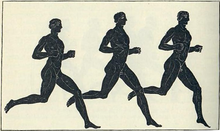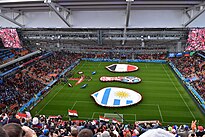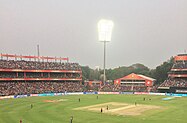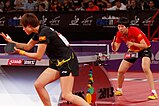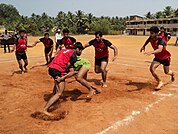
YMCA, sometimes regionally called the Y, is a worldwide youth organization based in Geneva, Switzerland, with more than 64 million beneficiaries in 120 countries. It was founded in London on 6 June 1844 by George Williams as the Young Men's Christian Association. The organization aims to put Christian values into practice by developing a healthy body, mind, and spirit.

Sociology of sport, alternately referred to as sports sociology, is a sub-discipline of sociology which focuses on sports as social phenomena. It is an area of study concerned with the relationship between sociology and sports, and also various socio-cultural structures, patterns, and organizations or groups involved with sport. This area of study discusses the positive impact sports have on individual people and society as a whole economically, financially, and socially. Sociology of sport attempts to view the actions and behavior of sports teams and their players through the eyes of a sociologist.

Masculinity is a set of attributes, behaviors, and roles associated with men and boys. Masculinity can be theoretically understood as socially constructed, and there is also evidence that some behaviors considered masculine are influenced by both cultural factors and biological factors. To what extent masculinity is biologically or socially influenced is subject to debate. It is distinct from the definition of the biological male sex, as anyone can exhibit masculine traits. Standards of masculinity vary across different cultures and historical periods.

Physical fitness is a state of health and well-being and, more specifically, the ability to perform aspects of sports, occupations, and daily activities. Physical fitness is generally achieved through proper nutrition, moderate-vigorous physical exercise, and sufficient rest along with a formal recovery plan.
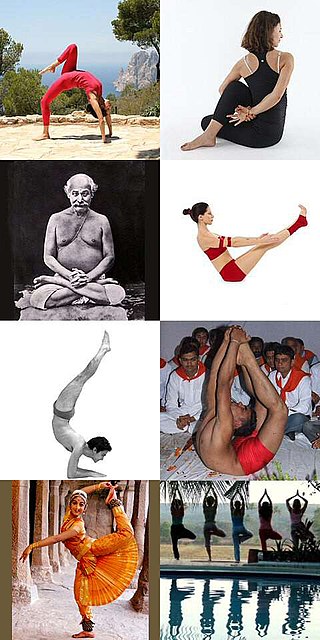
An āsana is a body posture, originally and still a general term for a sitting meditation pose, and later extended in hatha yoga and modern yoga as exercise, to any type of position, adding reclining, standing, inverted, twisting, and balancing poses. The Yoga Sutras of Patanjali define "asana" as "[a position that] is steady and comfortable". Patanjali mentions the ability to sit for extended periods as one of the eight limbs of his system. Asanas are also called yoga poses or yoga postures in English.
Physical culture, also known as body culture, is a health and strength training movement that originated during the 19th century in Germany, the UK and the US.

Muscular Christianity is a philosophical movement that originated in England in the mid-19th century, characterized by a belief in patriotic duty, discipline, self-sacrifice, masculinity, and the moral and physical beauty of athleticism.
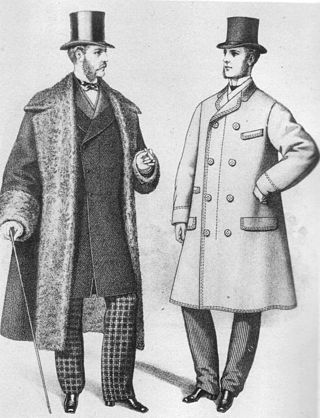
During the Victorian era, there were, as in all eras, certain social expectations that the separate genders were expected to adhere to in the United Kingdom and the British Empire. The study of Victorian masculinity is based on the assumption that "the construction of male consciousness must be seen as historically specific." The concept of Victorian masculinity is extremely diverse, since it was influenced by numerous aspects and factors such as domesticity, economy, gender roles, imperialism, manners, religion, sporting competition, and much more. Some of these aspects seem to be quite naturally related to one another, while others seem profoundly non-relational. For Victorian men, this included a vast amount of pride in their work, a protectiveness over their wives, and an aptitude for good social behaviour. The concept of Victorian masculinity is a topic of interest in the context of cultural studies with a special emphasis on gender studies. The topic is of interest in the areas of history, literary criticism, religious studies, and sociology. Those values that have survived to the present day are of special interest to critics for their role in sustaining the 'dominance of the Western male'.
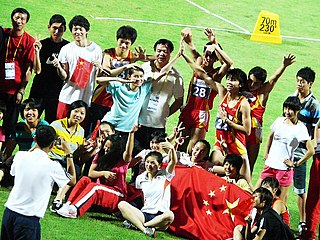
Youth sports is any sports event where competitors are younger than adult age, whether children or adolescents. Youth sports includes school sports at primary and secondary level, as well as sports played outside the education system, whether informally or organized.

Somatics is a field within bodywork and movement studies which emphasizes internal physical perception and experience. The term is used in movement therapy to signify approaches based on the soma, or "the body as perceived from within", including Skinner Releasing Technique, Alexander technique, the Feldenkrais Method, Eutony Gerda Alexander, Rolfing Structural Integration, among others. In dance, the term refers to techniques based on the dancer's internal sensation, in contrast with "performative techniques", such as ballet or modern dance, which emphasize the external observation of movement by an audience. Somatic techniques may be used in bodywork, psychotherapy, dance, or spiritual practices.

Fitness culture is a sociocultural phenomenon surrounding exercise and physical fitness. It is usually associated with gym culture, as doing physical exercises in locations such as gyms, wellness centres and health clubs is a popular activity. An international survey found that more than 27% of world total adult population attends fitness centres, and that 61% of regular exercisers are currently doing "gym-type" activities. Getting and maintaining physical fitness has been shown to benefit individuals' inner and outer health. Fitness culture has become highly promoted through modern technology and from the rising popularity of social media platforms.
Modern yoga is a wide range of yoga practices with differing purposes, encompassing in its various forms yoga philosophy derived from the Vedas, physical postures derived from Hatha yoga, devotional and tantra-based practices, and Hindu nation-building approaches.

Yoga as exercise is a physical activity consisting mainly of postures, often connected by flowing sequences, sometimes accompanied by breathing exercises, and frequently ending with relaxation lying down or meditation. Yoga in this form has become familiar across the world, especially in the US and Europe. It is derived from medieval Haṭha yoga, which made use of similar postures, but it is generally simply called "yoga". Academics have given yoga as exercise a variety of names, including modern postural yoga and transnational anglophone yoga.
Joseph S. Alter is an American medical anthropologist known for his research into the modern practice of yoga as exercise, his 2004 book Yoga in Modern India, and the physical and medical culture of South Asia.

Yoga is by origin an ancient spiritual practice from India. In the form of yoga as exercise, using postures (asanas) derived from medieval Haṭha yoga, it has become a widespread fitness practice across the western world. Yoga as exercise, along with the use that some make of symbols such as Om ॐ, has been described as cultural appropriation.

Western sports are sports that are strongly associated with the West. Many modern sports were invented in or standardized by Western countries; in particular, many major sports were invented in the United Kingdom after the Industrial Revolution, and later, America invented some major sports such as basketball and baseball.

Traditional Sports and Games (TSG) are physical activities which were played for centuries by people around the world before the advent of modern sports. Many TSG's lost popularity or died off during the colonial era due to the imposition and spread of Western sports. Further decline has occurred in the post-colonial era.

Muscular Hinduism is a philosophy that advocates for Hindus to be physically strong. Bankim Chandra Chatterjee and Swami Vivekananda are considered to have been major early proponents in the early 20th century. Muscular Hinduism intertwines with Hindu nationalism and communal violence in India.
Muscular Islam is a sometimes-used term to describe the push for physical fitness amongst Muslims.

Indian physical culture is the form of physical culture practiced in India.
